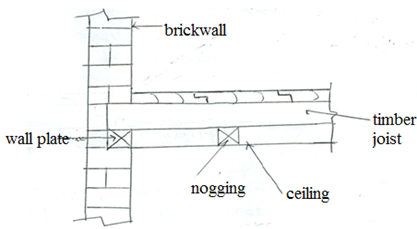Question 1
(a) Give one example of each of the following types of building:
(i) Commercial building;
(ii) Private building;
(iii) Public building.
(b) state three safety precautions to be taken when using a concrete mixer.
(c) sketch a cross-section through a timber upper floor and label the following parts:
(i)Brick wall;
(ii)Timber joist;
(iii) Wall plate;
(iv) Nogging.
Observation
Majority of the candidates were able to:
- give one example of commercial, private and public building;
- state three safety precautions to be taken when using a concrete mixer.
However, some of them were not able to:
- sketch a cross-section through a timber upper floor and label the following parts:
- Brick wall;
- Timber joist;
- Wall plate;
- Nogging.
The expected response to question 1 is as given below:
1 (a) One example of each of the following types of building:
(i) Commercial buildings: supermarkets, locked-up shops, office, eatery or restaurant,bookshop(event centre) shoping malls, hotels, gas stations
(ii)Private buildings: residential accommodation,flat, duplex, bungalow, storey building owned by private individuals.
(iii)Public buildings: hospital, school, office, mosque, police station, post office, Church, Library, town hall
(b) Three safety precautions to be taken when using a concrete mixer:
- Adhering to manufacturer’s instructions in the operational manual;
- The concrete mixer should be operated by trained or competent personnel;
- Periodic/regular maintenance of the concrete mixer;
- Checking both the oil level and water level of the engine before starting the equipment;
- Concentration must be maintained while operating the machine;
- The concrete mixer should be positioned on a flat levelled ground;
- The concrete mixer should not be overloaded beyond its capacity in a batch;
- The operator/labourer should wear relevant safety clothing during concreting operation.
(c) Section of a single Joist upper Floor;

